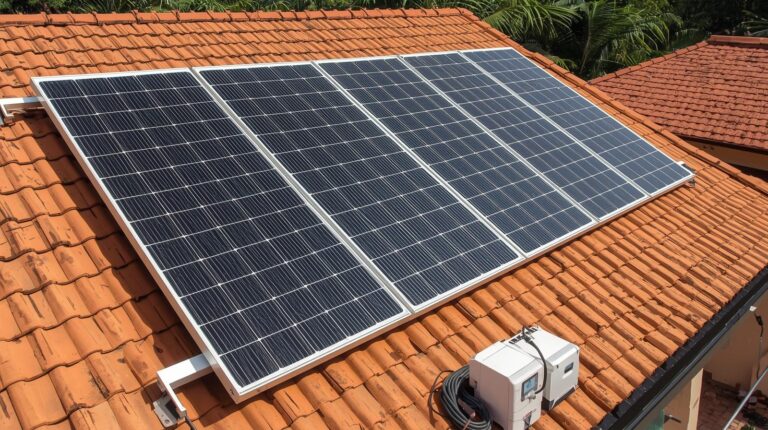To effectively leverage the advantages of advanced photovoltaic cell technology, it is vital to prioritize higher energy conversion efficiency through the adoption of cutting-edge materials and innovative manufacturing techniques.
Emphasizing the use of perovskite and organic compounds, optimizing multi-junction cell designs, and employing thin-film technology can greatly boost performance and reliability while simultaneously reducing costs and environmental impact.
Additionally, harnessing government incentives, integrating artificial intelligence for system optimization, and focusing on pioneering research areas like nanotechnology are key strategies. These approaches promise to revolutionize the photovoltaic landscape, but how can they be effectively implemented to maximize their potential?
Key Takeaways
- Integrate AI technologies to optimize energy conversion efficiency and predictive maintenance.
- Utilize government incentives and support to reduce costs and enhance adoption.
- Implement advanced materials like perovskite to boost energy conversion efficiencies.
- Employ innovative manufacturing techniques for scalability and cost reductions.
- Focus on versatile applications to maximize energy production across various environments.
Higher Energy Conversion Efficiency
Advanced solar cells are revolutionizing the solar energy industry with energy conversion efficiencies surpassing 25%, driven by innovations in materials and design. This remarkable leap in efficiency is largely attributed to the integration of cutting-edge materials such as perovskite and organic compounds, which have demonstrated significant potential in enhancing energy conversion. By effectively harnessing a broader spectrum of solar radiation, these materials facilitate higher energy output, making solar power a more viable alternative to traditional energy sources.
Multi-junction solar cells exemplify this technological advancement by incorporating multiple layers, each optimized to absorb different portions of the solar spectrum. This design maximizes energy conversion, thereby pushing the boundaries of solar efficiency. Additionally, thin-film solar cells offer a compelling combination of flexibility and cost-effectiveness, enabling diverse applications without compromising performance.
These advancements are not merely incremental improvements but represent a transformative shift towards more sustainable and efficient solar energy solutions. As the global demand for clean energy intensifies, the adoption of these high-efficiency solar cells can catalyze the shift towards a more liberated energy landscape, reducing reliance on fossil fuels and mitigating environmental impacts.
Embracing these innovations is essential for achieving a sustainable and energy-efficient future.
Enhanced Performance and Reliability
Building upon the remarkable leap in energy conversion efficiency, the enhanced performance and reliability of advanced photovoltaic cells stem from the integration of superior materials and innovative designs.
These advancements contribute significantly to the sustainability and effectiveness of solar energy systems, ensuring that they meet the demanding requirements of diverse applications.
The superior performance of advanced PV cells is characterized by:
- Increased electricity production: Higher energy conversion rates lead to more efficient electricity generation, maximizing output even under suboptimal conditions.
- Enhanced durability: Advanced materials, such as thin-film and multi-junction cells, offer greater durability, reducing the frequency of maintenance and replacement.
- Improved stability: Innovations in cell design enhance the stability of PV systems, guaranteeing consistent performance over longer periods.
- Optimal energy capture: Superior designs guarantee that advanced PV cells can capture and convert sunlight more effectively, even in low-light conditions.
- Extended system longevity: The integration of cutting-edge technologies results in systems that remain reliable and functional over extended lifespans.
These attributes collectively elevate the performance and reliability of photovoltaic systems, making them a cornerstone of sustainable energy solutions. By embracing these advanced PV cells, one can achieve freedom from traditional energy constraints, paving the way for a cleaner and more resilient energy future.
Superior Material Utilization
The utilization of cutting-edge materials such as perovskite and organic compounds in photovoltaic cells greatly enhances their energy conversion efficiency and overall performance. These advanced materials are pivotal in capturing sunlight more effectively, thereby optimizing the energy output of solar panels.
Through innovative manufacturing processes, the intricacies of creating multi-junction and thin-film solar cells are refined, contributing to superior material utilization. This not only boosts the energy production capabilities but also ensures higher reliability, durability, and longevity compared to conventional solar panels.
One of the significant benefits of leveraging advanced materials is the flexibility they offer in design and application, facilitating the development of versatile and adaptable photovoltaic systems. Moreover, the incorporation of these materials leads to notable cost savings.
By maximizing the energy-harvesting potential and minimizing material waste, manufacturers can produce highly efficient photovoltaic cells at a reduced cost. This aligns with the goal of sustainability, providing a more efficient and eco-friendly energy solution.
Cost-Effectiveness and Scalability
Cost-efficiency and scalability of advanced photovoltaic cells are pivotal in driving the widespread adoption of solar energy solutions. The enhanced energy conversion efficiency of these cells substantially lowers the cost per watt of solar energy production, making solar power a more competitive and attractive option.
This economic advantage is essential in promoting the shift from fossil fuels to renewable energy sources, thereby enabling a more sustainable and liberated energy landscape.
The scalability of advanced PV cells is another critical factor. Higher performance metrics allow for the deployment of larger solar arrays, effectively meeting the increasing energy demands of both residential and commercial sectors. Technological advancements have further augmented the energy output per unit area, optimizing the use of available space for solar installations.
Key benefits include:
- Cost-efficiency: Reduced overall cost per watt due to improved energy conversion efficiency.
- Scalability: Ability to install larger solar arrays to meet growing energy needs.
- Space Optimization: Maximized energy production per unit area.
- Sustainability: Reduced reliance on fossil fuels for electricity generation.
- Long-term Savings: Substantial cost savings over time.
Environmental Sustainability
Advanced photovoltaic cells contribute greatly to environmental sustainability by reducing carbon footprints through the utilization of renewable energy sources. These cells play an important role in minimizing waste and pollution, thereby supporting more efficient waste reduction practices.
Reduced Carbon Footprint
Harnessing solar energy through advanced solar cells greatly reduces the carbon footprint by generating clean electricity without emitting greenhouse gases. PV cells convert sunlight into electrical energy, thereby eliminating the need for fossil fuels and cutting down on harmful emissions. This process is crucial for environmental sustainability, as it directly mitigates the impact on the planet.
Each kilowatt-hour of solar electricity produced by advanced solar cells prevents approximately 0.8 kilograms of carbon dioxide from being released into the atmosphere. This reduction plays an important role in combating climate change and promoting a cleaner energy future. The adoption of these cells is not just a technological advancement but a step towards a more sustainable world.
Key benefits of advanced solar cells include:
- Reduction in Greenhouse Gases: Eliminates emissions that contribute to global warming.
- Decreased Reliance on Fossil Fuels: Lowers the dependence on non-renewable energy sources.
- Preservation of Natural Resources: Ensures that natural resources are not depleted.
- Mitigation of Climate Change: Contributes to global efforts in reducing the adverse effects of climate change.
- Support for Sustainability Goals: Aligns with international sustainability targets and initiatives.
Renewable Energy Source
As a renewable energy source, photovoltaic cells play a pivotal role in fostering environmental sustainability by converting sunlight into electricity without emitting pollutants. These advanced systems harness solar energy generation to greatly diminish carbon emissions, thereby promoting a cleaner, more sustainable energy landscape. By shifting to photovoltaic cells, we can decrease our dependence on fossil fuels, mitigating the adverse impacts of climate change.
The efficiency of advanced photovoltaic cells in converting sunlight to electricity not only reduces our environmental footprint but also supports a greener future. These cells do not produce harmful pollutants during the energy conversion process, ensuring a lower environmental impact compared to traditional energy sources. This makes them an integral component in the pursuit of sustainable energy solutions.
| Benefit | Environmental Impact |
|---|---|
| Reduced Carbon Emissions | Mitigates climate change |
| Clean Energy Production | Minimizes air and water pollution |
| Sustainable Energy Source | Decreases reliance on fossil fuels |
Waste Reduction Practices
By optimizing energy conversion efficiency and incorporating recycling programs, advanced photovoltaic cells greatly contribute to waste reduction and environmental sustainability. These cells not only minimize environmental impact but also support a more efficient resource utilization throughout their lifecycle.
The integration of advanced technologies within photovoltaic cells is pivotal in extending product lifespans, reducing the frequency of replacements, and the associated waste disposal. Key practices in waste reduction include:
- Enhanced Energy Conversion: Improved efficiency in energy conversion reduces the need for additional solar panels, thereby decreasing waste generation.
- Recycling Programs: Implementing robust recycling programs for obsolete solar panels allows the recovery of valuable materials like silicon, silver, and glass, promoting resource conservation.
- Extended Product Lifespans: Advanced photovoltaic technologies increase the durability and longevity of solar panels, reducing the need for premature replacements.
- High-Efficiency Upgrades: Upgrading to high-efficiency solar cells maximizes energy output per unit area, leading to a lower overall environmental footprint.
- Durability Features: Investing in photovoltaic cells with longer warranties and enhanced durability guarantees prolonged system longevity, contributing to significant waste reduction.
Versatile Applications
Advanced photovoltaic cells are revolutionizing the energy sector through their versatile applications in residential, commercial, and industrial settings, as well as in space exploration. These cells, integrated into solar panels, are pivotal for efficient electricity generation, powering homes, businesses, and even satellites.
The adaptability of advanced photovoltaic technology signifies a substantial leap towards achieving sustainable energy solutions on a global scale.
In residential settings, advanced photovoltaic cells are increasingly installed on rooftops, enabling homeowners to harness solar energy and reduce reliance on fossil fuels. Commercial buildings benefit from these cells through significant reductions in operational costs and carbon footprints. Utility-scale solar farms leverage the high energy conversion efficiency of advanced photovoltaic cells to generate vast amounts of clean electricity, supporting grid stability and energy security.
For industrial applications, the robust durability and enhanced performance in diverse lighting conditions make these cells ideal for powering remote operations and critical infrastructure. Additionally, portable solar chargers embedded with advanced photovoltaic cells provide off-grid electricity solutions, enhancing energy access in underserved regions and emergency situations.
Space exploration also benefits; satellites equipped with these cells can maintain prolonged missions, underscoring the reliability and resilience of this advanced technology.
Through these diverse applications, advanced photovoltaic cells are fundamental in propelling the shift to a cleaner, more sustainable energy future.
Innovations in Manufacturing
Harnessing the potential of advanced photovoltaic cells in diverse applications is made possible by groundbreaking innovations in manufacturing processes, which have driven notable cost reductions and efficiency improvements in recent years.
By adopting cutting-edge techniques and integrating smart technologies, the photovoltaic industry has achieved remarkable advancements that promise to revolutionize energy production. Key manufacturing innovations have included:
- Roll-to-roll manufacturing: This method has facilitated the mass production of flexible solar panels, expanding their utility across various sectors.
- Automation: Enhanced precision and consistency in manufacturing processes have resulted in higher quality and more reliable photovoltaic cells.
- Cost reductions: Over the past decade, the price of advanced photovoltaic cells has dropped significantly by over 80%, making solar energy more accessible.
- Efficiency improvements: Some advanced cells now achieve efficiencies above 25%, greatly boosting energy output.
- Smart technologies integration: These technologies have optimized production efficiency, reduced waste, and improved overall sustainability within the solar industry.
These manufacturing innovations are pivotal in shaping a future where photovoltaic technology can be widely adopted, offering a sustainable and economically viable alternative to traditional energy sources.
Government Incentives and Support
Government incentives, including tax credits and rebates, play a pivotal role in reducing the initial investment required for advanced photovoltaic cell installations.
Additionally, policy frameworks such as renewable portfolio standards and net metering amplify the financial viability and adoption of these technologies.
Research grants and funding further bolster innovation, driving advancements in photovoltaic efficiency and sustainability.
Research Grants Availability
With a focus on sustainability, research grants provide essential financial support for advancing photovoltaic cell technologies, enabling significant improvements in efficiency and performance.
These grants, primarily funded by government incentives, play a pivotal role in fostering innovation and driving the development of cutting-edge solar technologies. By offering financial assistance, they empower researchers and industry stakeholders to explore and implement novel approaches that enhance the capabilities of photovoltaic cells.
To illustrate the impact and availability of these research grants, consider the following points:
- Enhanced Efficiency: Grants support projects aimed at increasing the energy conversion efficiency of photovoltaic cells, making solar energy more viable.
- Collaborative Innovation: Funding encourages collaboration between academic institutions, research organizations, and private industries.
- Resource Allocation: Financial assistance allows for the acquisition of advanced materials and technologies essential for research.
- Sustainable Development: Grants promote long-term investments in sustainable energy solutions, reducing reliance on fossil fuels.
- Economic Growth: By driving advancements in solar technology, these grants contribute to job creation and economic expansion in the renewable energy sector.
Adoption Incentives Offered
Incentive programs, such as tax credits, rebates, and grants, play an important role in reducing the financial barriers to the adoption of advanced photovoltaic cell technologies. These incentives are pivotal in accelerating the deployment of advanced solar PV systems, making cleaner energy solutions more accessible to both residential and commercial sectors.
Government incentives can notably reduce the upfront costs associated with installing advanced photovoltaic systems. By doing so, they promote the shift towards sustainable energy sources. Collaborative efforts between governments, industry, and research institutions further drive innovation and adoption, ensuring that advanced photovoltaic technologies are implemented effectively and efficiently.
The following table outlines some common types of incentives and their respective benefits:
| Incentive Type | Description | Benefit |
|---|---|---|
| Tax Credits | Reductions in tax liability | Lowers overall project costs |
| Rebates | Direct cash payments or discounts | Immediate reduction in installation cost |
| Grants | Financial awards for specific projects | Provides funding for research and development |
| Feed-in Tariffs | Payments for energy produced | Ensures a steady revenue stream |
| Loan Programs | Low-interest financing options | Reduces financial burden over time |
Policy Framework Support
Policy framework support includes a wide range of government incentives and regulatory measures designed to facilitate the widespread adoption of advanced photovoltaic technologies.
These measures play a critical role in creating an environment conducive to innovation and sustainable growth in the solar energy sector. By offering financial assistance and fostering research and development, governments can expedite the deployment of cutting-edge photovoltaic systems.
Key aspects of effective policy framework support include:
- Government incentives such as tax credits and rebates that directly reduce the initial investment costs for advanced photovoltaic installations.
- Supportive policies that encourage extensive research and development activities, leading to technological breakthroughs and cost reductions.
- Regulatory frameworks that establish clear guidelines and standards, ensuring a stable and predictable market for solar energy technologies.
- Financial assistance programs tailored to assist both residential and commercial entities in the implementation of advanced photovoltaic systems.
- Collaborative initiatives between government agencies and industry stakeholders to drive innovation and foster a competitive market landscape.
These supportive policies and regulatory frameworks are essential for empowering individuals and businesses to shift to sustainable energy solutions, ultimately contributing to a decentralized and resilient energy future. By leveraging these government incentives, stakeholders can harness the full potential of advanced photovoltaic technologies, paving the way for a more sustainable and liberated energy landscape.
Integration With AI Technologies
Integrating AI technologies into photovoltaic systems greatly enhances their efficiency, operational cost-effectiveness, and overall performance. AI technologies can optimize solar panel efficiency by up to 25%, leveraging real-time data analysis to adjust settings based on dynamic weather conditions. This intelligent adaptation maximizes the energy capture and efficiency of photovoltaic cells, ensuring that solar energy systems operate at peak performance.
Predictive maintenance, powered by AI, is another transformative benefit. By detecting faults early, AI reduces downtime, ensuring continuous solar energy production and minimizing operational costs by up to 30%. The ability to preemptively address issues not only extends the lifespan of the equipment but also guarantees a more reliable energy supply.
Furthermore, AI-driven strategies enhance solar energy production and system reliability, leading to amplified energy yields and remarkable financial returns. By incorporating these cutting-edge technologies, solar energy systems become smarter and more efficient, fostering sustainability and environmental conservation.
The collaboration between AI experts and solar industry professionals is essential in realizing these advancements. This synergy promotes the development of sustainable energy solutions, empowering individuals and businesses to achieve energy independence and contribute to a cleaner, greener future.
Future Research Directions
Future research in advanced photovoltaic cells is poised to revolutionize the field by focusing on innovative materials like perovskite and organic compounds, which promise to greatly enhance efficiency and scalability. By exploring these novel materials, researchers aim to push the boundaries of what is possible in solar energy conversion, leading to higher efficiency and cost-effective solutions.
Advancements in nanotechnology are also being pursued to optimize light absorption and charge transport. These efforts are essential for creating next-generation photovoltaic cells that can deliver superior performance and reliability. Equally important is the investigation into tandem solar cells, which layer multiple materials to capture a broader spectrum of sunlight, thereby realizing the full potential of solar energy.
Key areas of research include:
- Perovskite materials: Enhancing stability and efficiency to compete with traditional silicon cells.
- Organic solar cells: Developing flexible, lightweight, and cost-effective photovoltaic solutions.
- Nanotechnology: Improving light absorption and charge transport mechanisms.
- Tandem solar cells: Increasing efficiency by combining multiple light-absorbing materials.
- Collaborative research: Fostering partnerships to drive technological advancements and sustainability.
Conclusion
Leveraging advanced photovoltaic cells necessitates investing in cutting-edge materials and innovative manufacturing processes. This enhances energy conversion efficiency, performance, and reliability. Superior material utilization, cost-effectiveness, and scalability are achievable through optimized multi-junction designs and thin-film technology.
Integrating AI technologies and capitalizing on government incentives further bolster system sustainability. Future research in perovskite materials and nanotechnology will drive continued advancements, ensuring the long-term effectiveness and environmental sustainability of photovoltaic systems.




